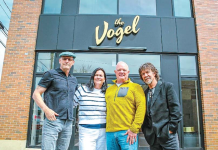
By Allison Perrine
A pilot program to begin developing Officer’s Row at Fort Hancock may soon be underway after a general agreement from advisory committee members last Friday.
During the virtual April 23 Fort Hancock 21st Century Advisory Committee meeting, committee members and National Park Service (NPS) staff discussed plans to move forward with the development of one or two buildings at the site at the tip of Sandy Hook and analyze the outcomes before fully moving forward with the latest project proposal brought by Stillman Development International. The project remains largely conceptual at this point.
“The purpose of today’s meeting is to get restarted since we haven’t met for various reasons since late February of last year and a lot has happened in the interim,” said Jennifer T. Nersesian, superintendent of Gateway National Recreation Area.
The meeting kicked off with introductions from committee members, whose professional backgrounds range from municipal and county government to NPS workers, environmental commission and planning board members, administrative roles, historic preservation and more. Nersesian shared park updates since the COVID-19 pandemic hit last year.
According to Nersesian, the past year has been about adapting to state and local guidelines. Sandy Hook was closed at the beginning of the 2020 season but, despite that, visitation was up, including weekday visitation.
In 2021, projects are excepted to pick up, she said, including exterior renovation work to the theater and lifesaving stations; rehabilitation of the Guardian Park Restroom, a historic building and former morgue for the post; and upgrades to water plant filtration system. And with last year’s congressional approval of the Great American Outdoors Act, the NPS will receive federal funds to spend on deferred maintenance projects. According to Nersesian, Gateway has one of the highest deferred maintenance tabs of all parks throughout the NPS, if not the highest, at about $200,000.
There are six buildings currently being leased at the fort. Buildings 23 and 56 are being rehabilitated in partnership with Monmouth County for the Marine Academy of Science and Technology (MAST) school; Building 53 which is now McFly’s on the Hook, offers snacks and drinks to visitors; Building 52 is a short-term rental facility; Building 104 is under construction but will soon be a residence and office; and Building 21, also used for short-term rentals.
Some additional buildings are currently subject to letters of intent, meaning architectural drawings are being proposed for them and negotiations are in process. Those buildings include 24 and 25, former barracks facilities, to be converted to multiunit residences; Building 36, a former mule barn, which could become a restaurant, bar and event space; Building 40, a former gymnasium, slated for event space and dining; and Building 114, the former officer’s club, which would become event space, dining and lodging.
The last in-person committee meeting was held Feb. 28, 2020, when representatives of Stillman Development International addressed the project’s proposed uses and preservation methods. It was met with “strong support” at the time from the advisory committee and Middletown Township and Monmouth County governments, according to Nersesian.
But others voiced concerns after the meeting, including U.S Rep. Frank Pallone (D-6) and some environmental organizations. NPS staff agreed to hold off on any next steps for the project at the time due to the expressed concerns and the emerging COVID-19 pandemic.
Months later, in November 2020, the committee met virtually to discuss the project with the public. The proposal impacts all remaining buildings along Officer’s Row as well as four other structures. Building 60, the former gas station, was slated to become something like a bodega with a liquor license; it is now a planned ice cream shop. Stillman wants to proceed with that project separate from the others.
The plans also include building 93 residential apartments spread out among the remaining buildings at Officer’s Row with short-term, long-term, corporate and seasonal leases. At Building 80, Stillman has plans for short-term rentals to support the adjacent wedding chapel on-site.
Members of the public both supported and disapproved of the plans. According to Nersesian, most concerns centered around limiting public access; capacity issues, specifically the density of units; negative impacts to the natural environment; and creating facilities only accessible to those with higher incomes.
“We have not moved forward on signing any type of agreement, such as a letter of intent (LIO), as we’ve worked our way through the challenges of last year,” she said. “What we have proposed for consideration, instead of an LIO on all the buildings, is a general agreement under which we would move forward on designs for one or two buildings with Stillman as a pilot to help determine what’s feasible and give us the opportunity to see if we can come up with solutions that help address some of the concerns that have been brought forward.”
She added that Stillman understands the concerns expressed by the public, especially about the density of the project as well as comments about wealthy people being the only ones who could afford to take advantage of the project. With that in mind, Stillman proposed including some housing for veterans.
But Pallone shared some concerns about that as well. During the April 23 meeting, Matt Montekio read a statement on behalf of Pallone who could not attend. He said Pallone “has concerns regarding the types of services that veterans may need for their quality of life including health care and transportation, especially given Sandy Hook’s remoteness.”
“We just want to make sure that that is something that is seriously considered,” Montekio read. He added that Pallone’s main opposition to the proposal as a whole “remains that the development will bring a large and permanent residential community to Sandy Hook,” he said. However, Pallone is OK with the pilot program and the proposed ice cream shop.
To give others who, like Pallone, may have concerns about the project a chance to voice their opinions, the advisory committee plans to establish “working groups.” The groups would develop recommendations to improve the leasing program to best meet NPS goals of natural resource protection, historic preservation and visitor enjoyment while taking into consideration the community’s concerns.
“The working group structure allows us to bring in people from the outside who are not formally appointed by the Secretary of Interior, and the working group would report to the committee and then the committee… would decide whether to move this forward in any way,” said Gerry Glaser, committee co-chair.
The groups will be made up of existing committee members, representatives from community organizations and/or individuals who have expressed concerns with the Stillman proposal. But Assemblyman Gerry Scharfenberger warned that this could bring some complications.
“We have to be careful not to get the type of objectors who are philosophically opposed to any sort of private money coming in, and I’ve heard it first-hand – the comments are ‘Let the buildings fall down,’ ” said Scharfenberger. “If you bring that kind of folks onto a working committee, I’m afraid it would paralyze the whole thing.”
However, he said the idea for the group in general is great and he welcomes objectors to join who are willing to work with what’s proposed.
After the meeting, Jeff Tittel, director of the NJ Sierra Club, issued a statement with concerns about the pilot program.
“When it comes to privatization, doing a pilot program is like the camel putting its nose in the tent. Once they do this, it will lead to an expanded pilot program and then privatization,” he wrote. “Instead, we should be coming up with a real plan to fix up the park and maintain public access. These areas can’t become private enclaves.”
The article originally appeared in the April 29 – May 5, 2021 print edition of The Two River Times.














